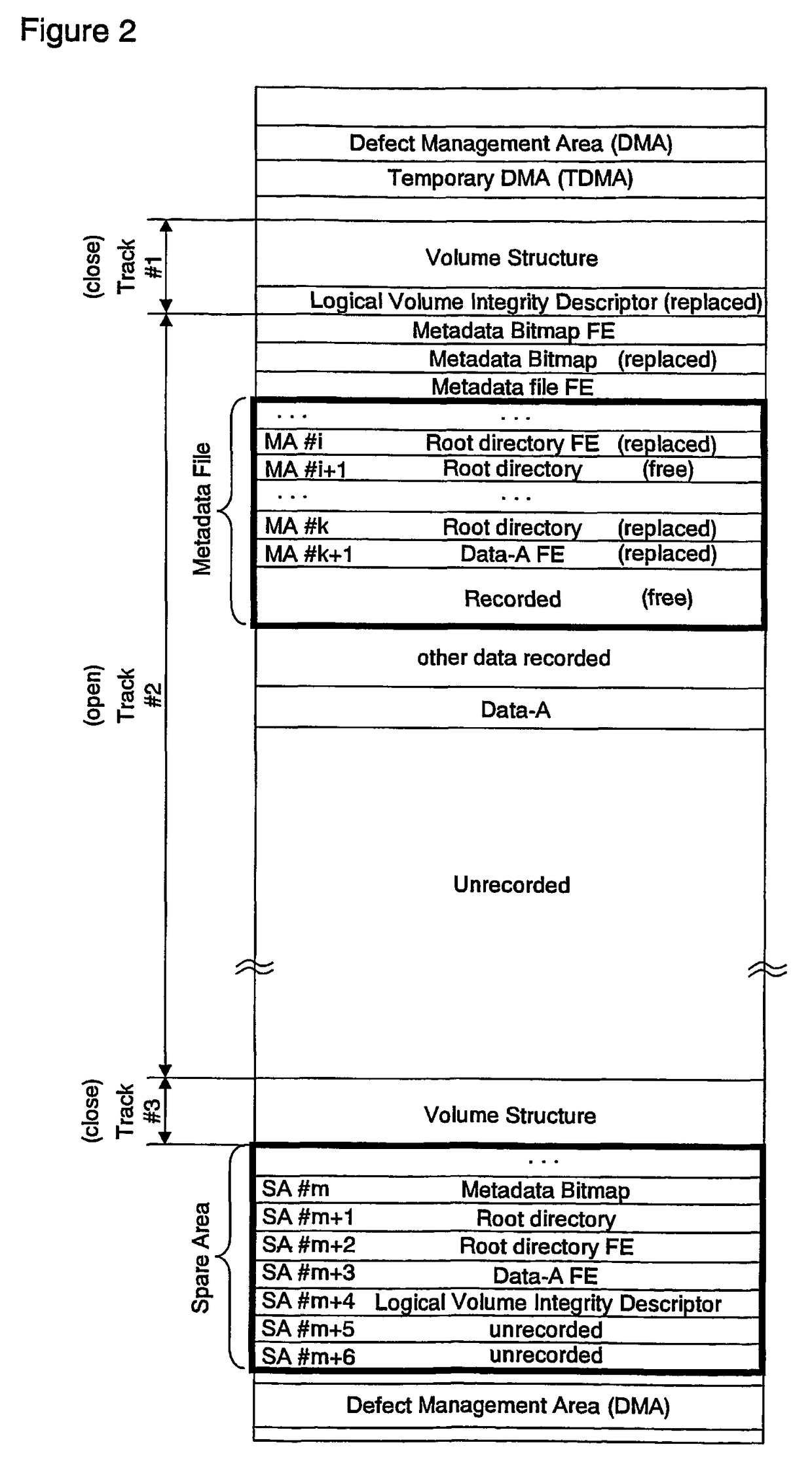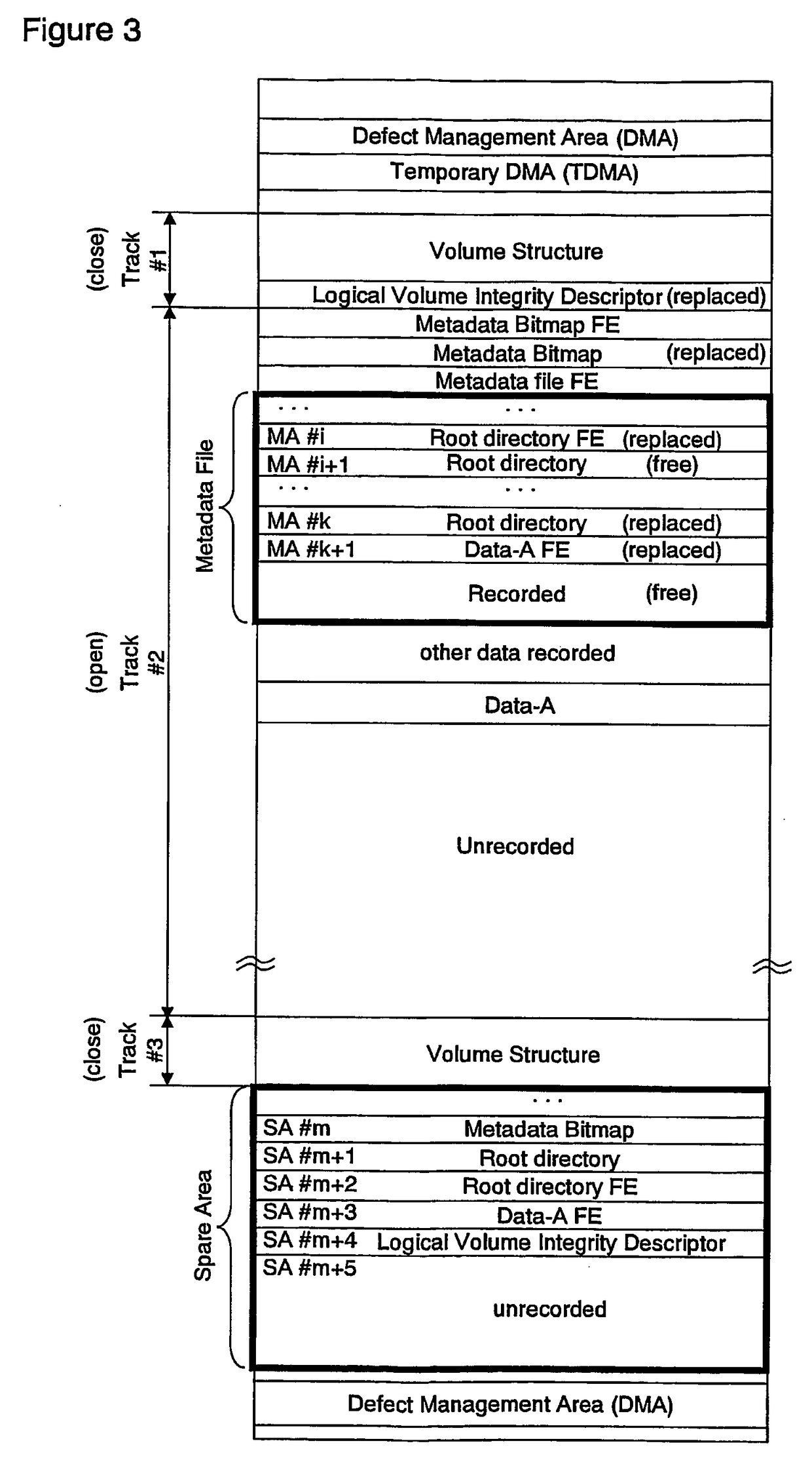Pseudo-overwriting data on write-once discs
a write-once disc and data technology, applied in the field of write-once disc recording methods, can solve the problems that the data appending partition cannot be used for data appending on the write-once disc, and it is difficult to develop a new recording method for the write-once dis
- Summary
- Abstract
- Description
- Claims
- Application Information
AI Technical Summary
Benefits of technology
Problems solved by technology
Method used
Image
Examples
embodiment 1
[0039]The amount of the overwritten data can be reduced by optimizing the procedure in the file system. In this embodiment, the basic read / write operation is explained in accordance with the new recording method for the drive apparatus with the overwritable function of a write-once disc.
[0040]Hereinafter, embodiments of the present invention will be described with reference to the drawings.
[0041]FIGS. 1 and 2 are diagrams showing a configuration of areas. FIG. 4 is a flowchart showing a procedure for recording a file. FIG. 1 shows the state where a file has been recorded after a logical format operation. FIG. 2 shows the state where a Data-A file has been recorded in a root directory on a disc having the state of FIG. 1.
[0042]Firstly, FIG. 1 will be described.
[0043]The data area includes the areas such as a Lead-in area, a volume space and a Lead-out area, (wherein the Lead-in area and the Lead-out area are managed by a physical layer). The physical sector is an addressable unit in ...
embodiment 2
[0073]This embodiment describes a further recording method to write a file onto a write-once disc on which the state is explained in embodiment 1 as FIG. 2.
[0074]In FIG. 2, the unrecorded area is only 2 sectors of SA #m+5 and #m+6, therefore, if the Metadata Bitmap and the root directory are written in the spare area, a file entry of the root directory, and a file entry of the file can not be written any more. Thus, an additional file can not be recorded, even if the Metadata Bitmap indicates available areas in the Metadata file, because the unrecorded area in the spare area is used up.
[0075]So, hereinafter a recording method to record the file with checking the size of unrecorded areas in the spare area is described.
[0076]FIG. 3 is a diagram illustrating a configuration of areas on the disc on which the same data as shown in FIG. 2 is written. In FIG. 3, as a spare area with the larger size has been provided by a logical formatting operation, the spare area has a larger unrecorded ...
embodiment 3
[0089]In the previous embodiment 2, the spare area with sufficient size has to be assigned at the time of formatting on a write-once disc. However, a user cannot know how many files and the size of the files that will be recorded on the disc, therefore, it is difficult to decide the appropriate size of the spare area at the time of formatting. If all of the spare area is used, no file can be recorded on the disc, even if the unrecorded area remains in the user data area. On the other hand, if a larger spare area is assigned, after all of the user data area is used, unrecorded area may remain in the spare area.
[0090]Further, a file system driver has to check the size of the unrecorded area in the spare area each time when a file is recorded, hence the space management becomes difficult to implement. This is not suitable for the implementation of file system driver of computer systems.
[0091]So, hereinafter a recording method in which the direction to replace the data not only within t...
PUM
| Property | Measurement | Unit |
|---|---|---|
| physical address | aaaaa | aaaaa |
| volume | aaaaa | aaaaa |
| physical characteristics | aaaaa | aaaaa |
Abstract
Description
Claims
Application Information
 Login to View More
Login to View More - R&D
- Intellectual Property
- Life Sciences
- Materials
- Tech Scout
- Unparalleled Data Quality
- Higher Quality Content
- 60% Fewer Hallucinations
Browse by: Latest US Patents, China's latest patents, Technical Efficacy Thesaurus, Application Domain, Technology Topic, Popular Technical Reports.
© 2025 PatSnap. All rights reserved.Legal|Privacy policy|Modern Slavery Act Transparency Statement|Sitemap|About US| Contact US: help@patsnap.com



